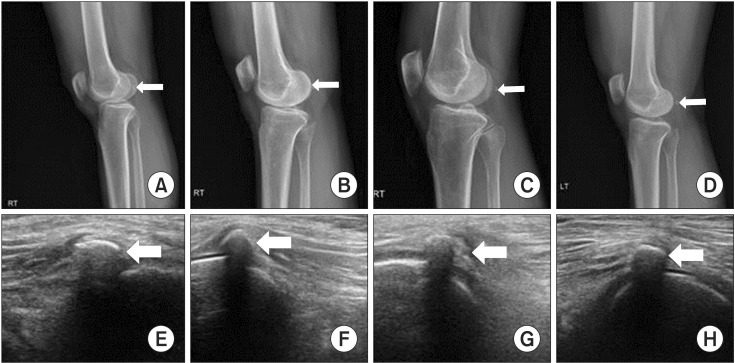Ann Rehabil Med.
2016 Dec;40(6):1124-1128. 10.5535/arm.2016.40.6.1124.
Effect of Radial Extracorporeal Shock Wave Therapy in Patients With Fabella Syndrome
- Affiliations
-
- 1Department of Physical Medicine and Rehabilitation, Sahmyook Medical Center, Seoul, Korea. btjrbj@gmail.com
- KMID: 2371346
- DOI: http://doi.org/10.5535/arm.2016.40.6.1124
Abstract
- The fabella is a small sesamoid bone generally located in the tendon of the lateral head of the gastrocnemius behind the lateral condyle of the femur. Fabella syndrome is the occurrence of posterolateral knee pain associated with the fabella. It is a rare cause of knee pain that is often misdiagnosed. Fabella syndrome can be managed with conservative or surgical treatment. We applied radial extracorporeal shock wave therapy as a new treatment strategy for fabella syndrome and achieved a successful outcome.
Figure
Reference
-
1. Kawashima T, Takeishi H, Yoshitomi S, Ito M, Sasaki H. Anatomical study of the fabella, fabellar complex and its clinical implications. Surg Radiol Anat. 2007; 29:611–616. PMID: 17882346.
Article2. Zeng SX, Dong XL, Dang RS, Wu GS, Wang JF, Wang D, et al. Anatomic study of fabella and its surrounding structures in a Chinese population. Surg Radiol Anat. 2012; 34:65–71. PMID: 21626275.
Article3. Duncan W, Dahm DL. Clinical anatomy of the fabella. Clin Anat. 2003; 16:448–449. PMID: 12903068.
Article4. Franceschi F, Longo UG, Ruzzini L, Leonardi F, Rojas M, Gualdi G, et al. Dislocation of an enlarged fabella as uncommon cause of knee pain: a case report. Knee. 2007; 14:330–332. PMID: 17490883.5. Zenteno Chavez B, Morales Chaparro IF, De la Torre IG. Fabella syndrome in a high performance runner: case presentation and literature review. Acta Ortop Mex. 2010; 24:264–266. PMID: 21305764.6. Weiner DS, Macnab I. The “fabella syndrome”: an update. J Pediatr Orthop. 1982; 2:405–408. PMID: 6815224.7. Zipple JT, Hammer RL, Loubert PV. Treatment of fabella syndrome with manual therapy: a case report. J Orthop Sports Phys Ther. 2003; 33:33–39. PMID: 12570284.
Article8. Driessen A, Balke M, Offerhaus C, White WJ, Shafizadeh S, Becher C, et al. The fabella syndrome: a rare cause of posterolateral knee pain: a review of the literature and two case reports. BMC Musculoskelet Disord. 2014; 15:100. PMID: 24666711.
Article9. Friedman L, Finlay K, Jurriaans E. Ultrasound of the knee. Skeletal Radiol. 2001; 30:361–377. PMID: 11499776.
Article10. Chang KV, Chen SY, Chen WS, Tu YK, Chien KL. Comparative effectiveness of focused shock wave therapy of different intensity levels and radial shock wave therapy for treating plantar fasciitis: a systematic review and network meta-analysis. Arch Phys Med Rehabil. 2012; 93:1259–1268. PMID: 22421623.
Article
- Full Text Links
- Actions
-
Cited
- CITED
-
- Close
- Share
- Similar articles
-
- Current Concepts in Extracorporeal Shock Wave Therapy
- The Clinical Results of Radial and Focused Extracorporeal Shockwave Therapy on Periscapular Myofascial Pain Syndrome
- Treatment of Nonunion of Tibia with Extracorporeal Shock Wave Therapy: A Case Report
- Suggestions for Effective Extracorporeal Shock Wave Treatment Methods for Lateral Epicondylitis
- Effects of Extracorporeal Shock Wave Lithortripsy Experimentally Induced Cholelithiasis and Organs in the Dog


